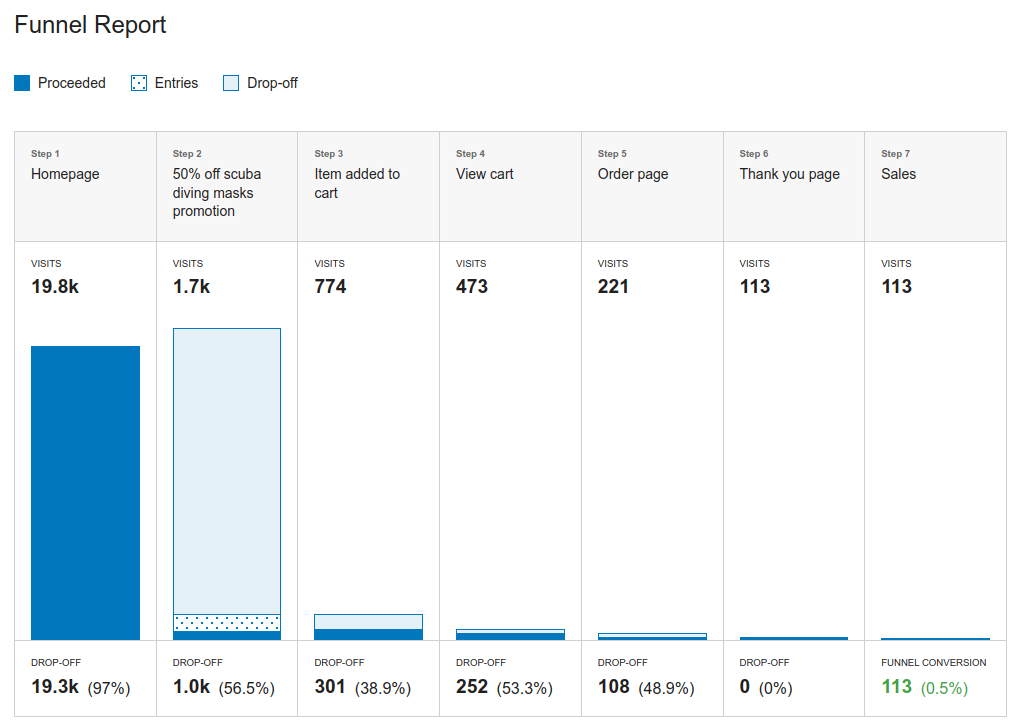Funnels
A Funnel is a series of actions that you expect your visitors to take as they progress through your website. For example, if you run an ecommerce store your primary goal may be for a visitor to make a purchase but there could be several key steps along the way:
- Enters website
- Clicks on product page
- Adds a product to their cart
- Goes to the checkout page
- Visitor completes purchase
These steps make up a relatively simple but very common funnel design with up to five steps. Every one of these steps is a moment where visitors can potentially exit your funnel. So, while it is useful to track how many visitors make a purchase as a primary goal, it can also be useful to track progression through each step of the funnel.
This is where the FirstHive Analytics Funnels feature comes in as it allows you to track your visitors’ progression through key conversion steps towards a goal. The example funnel report simplified below shows that visitors can and do commonly fall off throughout the funnel. While there have been almost 20,000 visits to the website, only 1778 even made it to the product page. Following that, only 113 actually ended up making a purchase.

This level of funnel analysis can help you to understand exactly which steps your visitors are falling off at. Armed with this information, you can take steps to optimise the earlier steps of your funnel. The more visitors that make it through each step, the more they have a chance to convert at the later stages.
Funnels represent the steps a user takes to achieve your goals for your website. Funnel analytics can provide useful insights into your user experience. They can help to identify where visitors drop off and potential improvements.
Optimising earlier stages of your funnel should also have flow-on effects for later stages of your funnel. The more people that enter the later stages of your funnel – even with the same conversion rates – the more goal completions you should receive. Thus improving your Goal conversion rates and revenue. Users have the flexibility to set up a funnel without linking it to a specific goal. In this configuration, the last step of the funnel represents the desired action for visitors. Optimising the preceding steps remains advantageous, ensuring a smoother visitor journey towards the intended action.
Funnel reports give you actionable insights for growing your business:
- Identify user bottlenecks: If you notice an unusually high drop off at a certain stage, it deserves attention. High drop-off rates could mean something is hindering progression from that stage. Are there visual bugs on the page? Are there elements which may be reducing trust?
- Reveals confusing steps: It should always be clear what action a user needs to take next. If it isn’t, they may simply exit your site and this will show in funnel reports. When optimising for conversions, you want to make it as easy as possible for users to travel through each step of your conversion funnel.
- Aids with discovering bugs: If you have consistent funnel conversion rates over time, and they drop off at a specific stage, it is likely a new problem. This could be a broken page, missing buttons or links, or something as simple as a drop in trust or clarity due to visual or content changes made on the page.
- Act as a trigger for deeper analysis: If a certain stage of the funnel has a low conversion rate, it might inspire further analysis. For example, looking at the page performance report may reveal a page within your funnel is slower than others after adding a new widget. This would imply removing the widget could help improve your conversion rate on that stage of the funnel.
Overall funnel analytics are a key diagnostic tool to help you improve your entire goal conversion path to ensure better results.
